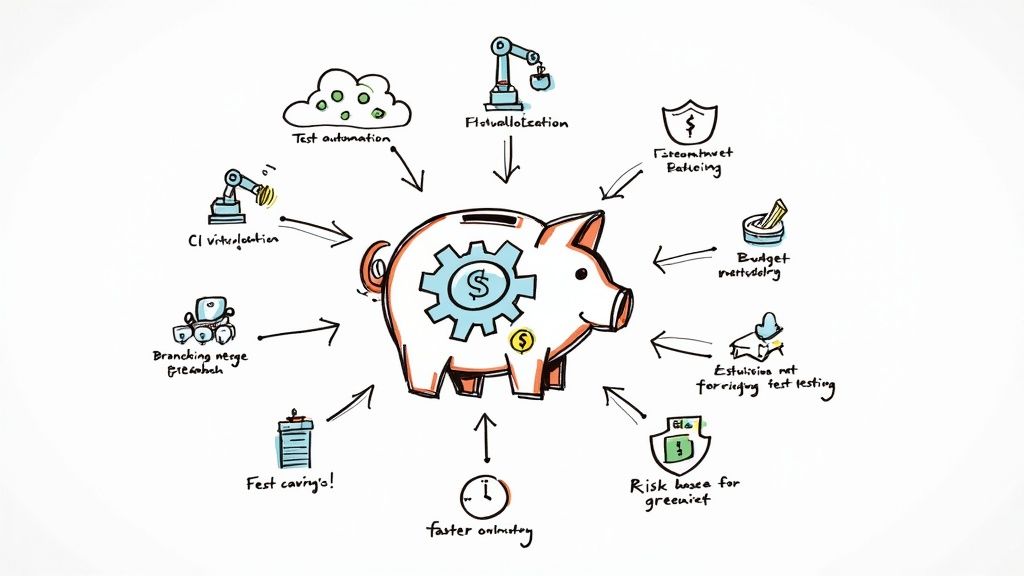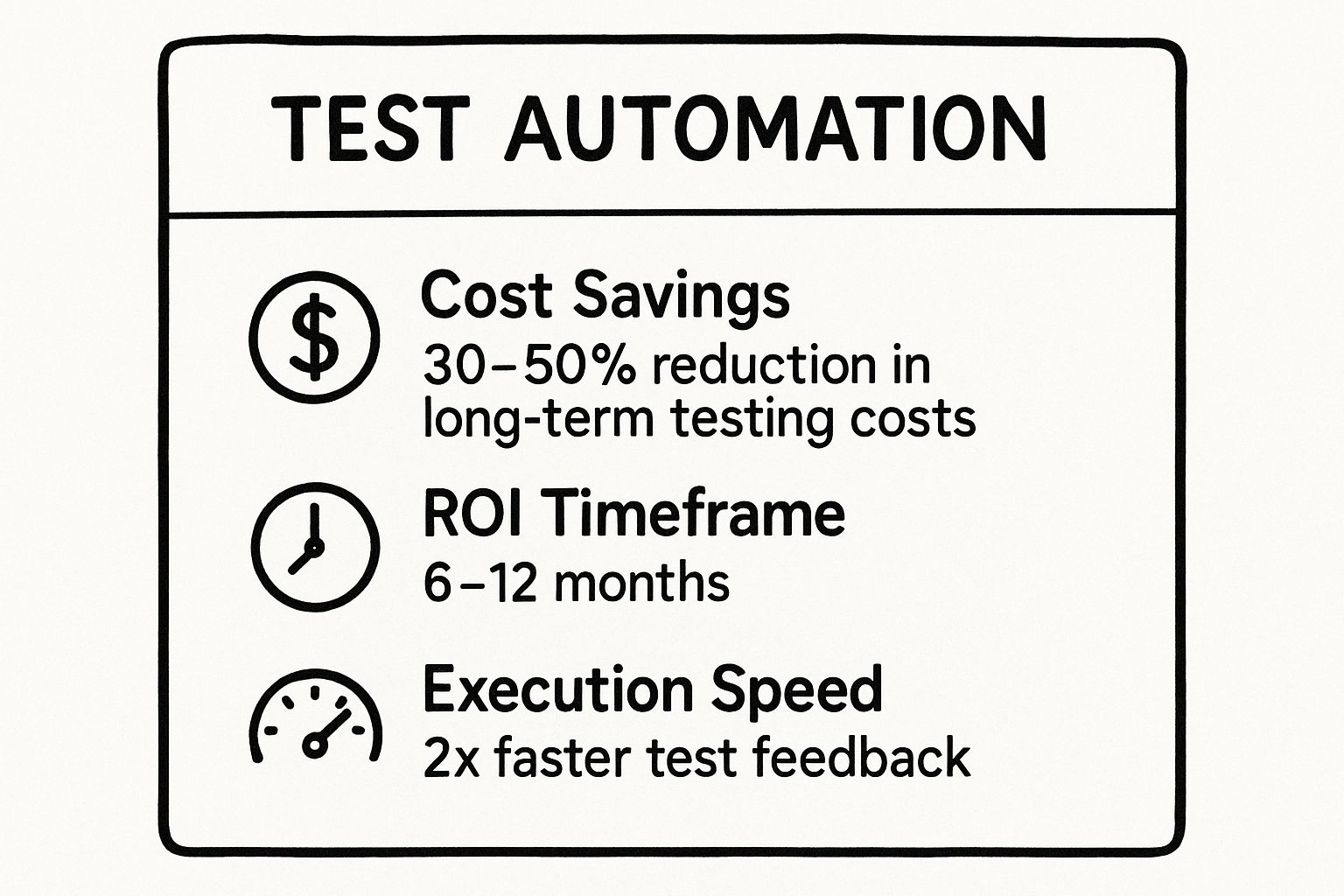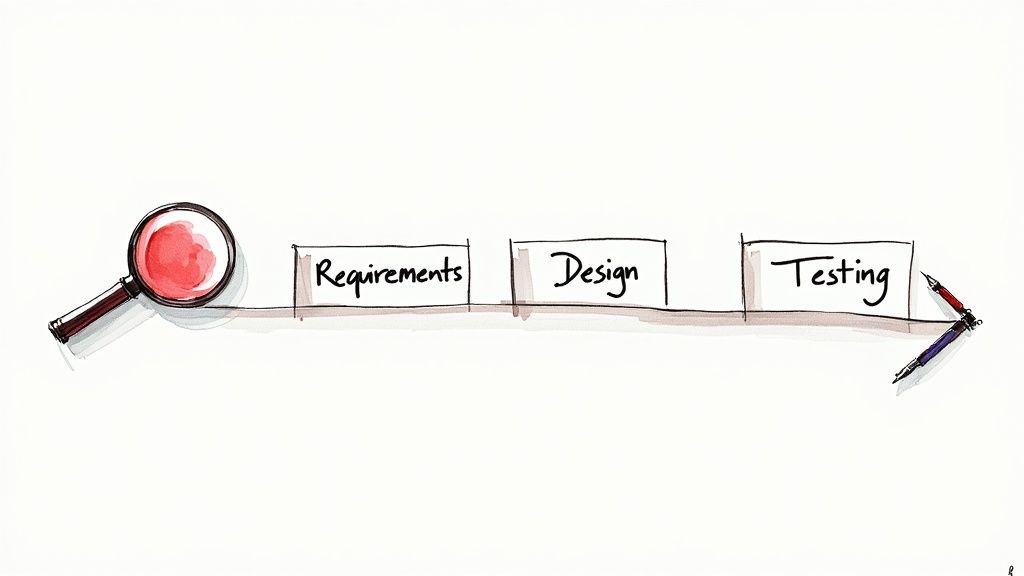8 Smart Ways to Reduce Software Testing Costs in 2025

In a competitive landscape, engineering teams are under constant pressure to deliver high-quality software faster while keeping budgets in check. Software testing, a critical component of the development lifecycle, is often viewed as a significant cost center. However, escalating expenses don't have to be an unavoidable reality. The key isn't to test less, but to test smarter. By adopting modern strategies and leveraging powerful tools, you can transform your testing process from a financial drain into a strategic advantage that accelerates delivery and boosts your bottom line.
This article explores eight powerful, actionable strategies designed to help you significantly reduce software testing costs, enhance efficiency, and improve overall product quality. We'll move beyond generic advice to provide practical implementation details on topics including:
- Strategic test automation and shift-left approaches.
- Risk-based testing and efficient data management.
- Optimizing CI/CD pipelines and leveraging cloud infrastructure.
We will provide real-world examples and fresh perspectives on how to optimize every dollar of your testing budget. Forget the theory; this is your practical guide to building a cost-effective, high-impact testing function.
1. Embrace Strategic Test Automation
Transitioning from manual to automated testing is one of the most impactful ways to reduce software testing costs over the long term. Strategic test automation uses software tools to execute repetitive, predictable test cases automatically. This frees up your skilled QA engineers from mundane, time-consuming tasks, allowing them to focus on high-value activities like exploratory, usability, and ad-hoc testing where human intuition and creativity are essential.
The goal isn't to automate 100% of tests, but to create a robust safety net for critical functionalities. Companies like Netflix have leveraged this approach to cut testing times by over 60% for their complex microservices architecture, while Spotify significantly shortened release cycles by automating regression testing.
How to Implement Strategic Automation
A successful automation strategy requires careful planning and execution. It's not just about writing scripts; it's about building a sustainable and efficient testing framework.
- Start Small and Stable: Begin by automating your most stable and repetitive test cases, such as regression tests for core features. These provide the quickest and most reliable returns.
- Integrate Early and Often: Weave automated tests directly into your CI/CD pipeline. This ensures that every code change is validated automatically, providing immediate feedback to developers and preventing bugs from progressing.
- Manage Test Data: Implement a solid test data management strategy. Automated tests are only as reliable as the data they use, so ensure you have a system for generating and maintaining clean, relevant test data.
The infographic below highlights the typical ROI and efficiency gains you can expect from a well-executed automation initiative.

As the data shows, the initial investment pays off within a year, leading to faster feedback loops and substantial long-term savings. To dive deeper into implementation, you can learn more about test automation best practices and maximizing your ROI.
2. Shift-Left Testing
The "shift-left" philosophy moves testing activities earlier in the software development lifecycle, fundamentally changing when and how quality is built into a product. Instead of waiting until the end of a cycle, testing becomes a continuous activity integrated from the very beginning. This proactive approach helps reduce software testing costs by catching defects when they are exponentially cheaper and faster to fix: during the requirements and development phases.
By involving testers and quality considerations early, you prevent bugs from being built in the first place. This model has been famously adopted by major tech companies; for instance, Microsoft reduced post-release defects for Office 365 by 70%, and IBM cut testing costs for its cloud services by 40% by implementing shift-left principles.

How to Implement Shift-Left Testing
Successfully shifting left involves a cultural and process-oriented change, empowering developers to take more ownership of quality with support from QA experts.
- Integrate Static Analysis: Use static code analysis tools directly within developer IDEs. These tools automatically scan code for potential bugs, security vulnerabilities, and style issues before it's even committed.
- Promote Developer-Led Testing: Encourage and train developers in unit and integration testing best practices. This ensures the foundational code components are solid before they are merged into the main branch.
- Establish a Clear "Definition of Done": Ensure your team’s Definition of Done for any task includes specific testing criteria. This makes quality a non-negotiable part of feature completion, rather than an afterthought.
- Implement Code Reviews: Formalize peer code reviews and pair programming sessions. These collaborative practices are excellent for catching logic errors and ensuring adherence to coding standards early on.
This approach transforms testing from a final gate into a shared responsibility, fostering a culture of quality throughout the entire development process. To explore this concept further, you can learn more about the principles and benefits of shift-left testing.
3. Implement Risk-Based Testing
Risk-based testing is a strategic approach that allocates testing efforts according to the level of risk each feature or component presents. This method helps reduce software testing costs by concentrating resources on the most critical, complex, and failure-prone areas of an application. Instead of aiming for uniform test coverage, you prioritize based on the potential impact of a failure on business operations, revenue, or user experience.
This targeted approach ensures that your most valuable assets are the most thoroughly tested. For instance, Volkswagen reduced its automotive software testing cycles by 35% by focusing on high-risk functions, while PayPal directs over 70% of its testing effort towards critical payment processing flows, safeguarding its core business function.
How to Implement Risk-Based Testing
A successful risk-based strategy requires a systematic approach to identifying, assessing, and mitigating risks. It shifts the testing mindset from "test everything" to "test what matters most."
- Identify and Assess Risks: Collaborate with business stakeholders, developers, and product managers to create a risk assessment matrix. Use historical defect data and business impact analysis to assign probability and impact scores to different application areas.
- Prioritize Test Efforts: Allocate your testing resources based on the risk scores. High-risk items (e.g., payment gateways, user authentication) should receive the most rigorous and comprehensive testing, including extensive automated regression and manual exploratory tests.
- Adapt and Re-evaluate: Risk is not static. Regularly review and update your risk assessment, especially after new features are added or the application architecture changes. This ensures your testing strategy remains aligned with the current state of your product.
By focusing your team's energy where it can prevent the most significant failures, you optimize resource allocation and deliver a more reliable product efficiently. To build a robust framework, you can explore this guide on software development risk management.
4. Test Data Management and Virtualization
Effective test data management is a cornerstone strategy to reduce software testing costs by tackling the often-overlooked expenses tied to data creation, storage, and maintenance. This approach involves systematically creating, maintaining, and provisioning high-quality data for testing environments. When paired with test data virtualization, which provides on-demand, simulated data environments, it becomes a powerful tool for accelerating test cycles while ensuring data privacy and compliance.
Inefficient data practices lead to bloated storage costs, prolonged test setup times, and risks of exposing sensitive production data. By optimizing this process, organizations can drastically improve efficiency. For instance, JPMorgan Chase cut data preparation expenses by 75% using synthetic data generation, while Salesforce accelerated its testing cycles by implementing test data virtualization for its complex CRM platform.
How to Implement Test Data Management
A strong data management strategy ensures that testers have the right data, at the right time, without compromising security or efficiency. It moves teams away from slow, risky full-production database clones.
- Implement Data Masking and Subsetting: Protect sensitive information by using data masking techniques to obscure personally identifiable information (PII). For most functional testing, use smaller, targeted subsets of production data instead of full copies to reduce storage needs and speed up environment provisioning.
- Create Reusable Data Templates: Develop standardized, reusable templates for generating test data. This approach, popularized by tools like CA Test Data Manager (now Broadcom) and Delphix, ensures consistency across tests and dramatically reduces the manual effort required for data creation.
- Enable Self-Service Data Provisioning: Empower your development and QA teams with self-service portals to request and provision the specific test data they need. This eliminates bottlenecks associated with centralized data teams and allows for faster, more agile testing.
By treating test data as a managed asset rather than an afterthought, you can significantly lower operational overhead and accelerate your release velocity. To learn more about advanced data virtualization techniques, you can explore the resources offered by pioneers like Delphix.
5. Leverage Cloud-Based Testing Environments
Adopting cloud-based testing is a powerful strategy to reduce software testing costs by eliminating the need for expensive on-premises hardware. This approach uses cloud infrastructure from providers like AWS, Azure, or Google Cloud to create scalable, on-demand testing environments. Teams can provision and tear down complex test setups in minutes, paying only for the resources they consume.
This pay-as-you-go model offers immense flexibility and cost-effectiveness, particularly for performance and load testing. For instance, Airbnb utilizes AWS to simulate millions of concurrent users, a feat that would be prohibitively expensive with physical servers. Similarly, Netflix validates its global streaming platform using cloud testing, ensuring reliability across diverse geographical locations without maintaining a worldwide physical infrastructure.

How to Implement Cloud-Based Testing
Successfully transitioning to the cloud requires more than just signing up for a service; it involves strategic planning to maximize benefits and control expenses.
- Automate Environment Provisioning: Use Infrastructure as Code (IaC) tools like Terraform or CloudFormation to automate the creation and destruction of test environments. This ensures consistency and prevents costs from spiraling due to forgotten, running instances.
- Embrace Containerization: Utilize Docker and Kubernetes to package your application and its dependencies into portable containers. This guarantees that your test environments are identical from local development machines to the cloud, eliminating "it works on my machine" issues.
- Optimize Resource Usage: Implement auto-scaling policies to dynamically adjust resources based on testing demand. Schedule non-critical test runs during off-peak hours when cloud resources are often cheaper.
By moving testing to the cloud, you trade high capital expenditures for predictable operational costs. To effectively adopt risk-based testing within this model, it's beneficial to understand various key risk management framework examples that can guide your resource allocation and testing priorities.
6. API Testing Focus
Prioritizing API testing is a highly effective strategy to reduce software testing costs by targeting the core business logic of an application. Instead of testing through the often brittle and slow user interface (UI), API testing validates the application programming interfaces (APIs) directly. This layer handles data exchange and business rules, making it a more stable and efficient point for verification.
This approach bypasses the UI's complexities, leading to faster execution and easier maintenance. Companies like Uber have leveraged extensive API testing to validate their complex ride-sharing logic, cutting test execution times by as much as 80%. Similarly, e-commerce giants like Shopify rely on robust API tests to ensure their platform's backend services can reliably support thousands of merchants and integrations.
How to Implement an API Testing Focus
Shifting focus to the API layer requires a strategic approach that integrates directly with your development lifecycle. It's about testing functionality closer to its source, where bugs are cheaper and faster to fix.
- Implement Contract Testing: Use contract testing to ensure that services (like a front-end and a back-end) communicate correctly without needing to run full end-to-end tests. This is crucial in microservices architectures.
- Leverage Specialized Tools: Employ dedicated API testing tools like Postman, Insomnia, or frameworks like REST Assured. These tools simplify the process of creating, executing, and automating API requests and assertions.
- Automate in the Pipeline: Integrate your API test suites into your CI/CD pipeline. This ensures that every build is validated at the service layer, providing rapid feedback and preventing integration issues from reaching production.
- Combine with Selective UI Testing: While API testing should form the bulk of your functional tests, it doesn't eliminate the need for UI testing. Use UI tests sparingly to validate critical user workflows and visual elements, creating a balanced and efficient test pyramid.
7. Continuous Integration and Continuous Testing
Adopting Continuous Integration (CI) and Continuous Testing is a foundational strategy to reduce software testing costs by shifting quality checks to the earliest stages of development. CI involves developers merging their code changes into a central repository frequently, after which automated builds and tests are run. This continuous feedback loop ensures that defects are caught immediately, preventing them from escalating into complex, costly problems later in the cycle.
This proactive approach minimizes the time and resources spent on lengthy, manual debugging and integration phases. Tech giants like Google and Meta exemplify this model, running billions of tests and deploying thousands of times daily. They rely on continuous testing within their CI pipelines to maintain velocity and quality, proving that speed and stability can coexist.
How to Implement CI and Continuous Testing
Integrating testing directly into your development workflow requires a disciplined approach and the right tools. The goal is to make testing a seamless, automated part of every code commit.
- Start with a Simple Pipeline: Begin by setting up a basic CI pipeline that triggers unit and integration tests on every commit. You can gradually add more complex stages like static analysis, security scans, and end-to-end tests.
- Establish Fast Feedback Loops: Prioritize running the fastest tests first, such as unit tests, to give developers immediate feedback. This allows them to fix issues while the context is still fresh in their minds, drastically cutting down on remediation time.
- Use Feature Flags: Implement feature flags to decouple deployment from release. This allows you to merge and test new features in the main branch without exposing them to users, enabling safe, continuous testing in a production-like environment.
Platforms like Jenkins and GitLab CI/CD were instrumental in popularizing this approach, offering the flexibility to build and scale robust testing pipelines. For more insights on building an efficient development workflow, explore how to optimize your CI/CD pipeline with a merge queue.
8. Utilize Crowdsourced Testing
Crowdsourced testing leverages a global, on-demand network of professional testers to uncover defects that in-house teams might miss. This approach offers a powerful way to reduce software testing costs by providing access to an immense pool of devices, operating systems, and real-world environments without the overhead of purchasing and maintaining them. Instead of relying solely on a fixed QA team, you can tap into a diverse crowd to perform exploratory, localization, and usability testing under real-world conditions.
This model is particularly effective for user-facing applications where experience varies wildly across different regions and hardware. For instance, Microsoft validates Office 365 features across global markets using crowdsourced testers, while Samsung uses the same approach to test mobile device compatibility on numerous international carrier networks. This ensures their products are robust and performant for a global user base.
How to Implement Crowdsourced Testing
Effectively harnessing a global crowd requires a structured approach to ensure you get high-quality, relevant feedback that aligns with your development goals.
- Define Scope and Acceptance Criteria: Be crystal clear about what needs to be tested, the expected outcomes, and the criteria for a bug to be considered valid. Vague instructions lead to wasted effort and irrelevant reports.
- Implement Strong Security Measures: When dealing with pre-release or sensitive applications, ensure the platform you use has strict NDAs and secure access protocols to protect your intellectual property. Reputable platforms like Applause and Testbirds specialize in this.
- Combine with Internal QA: Crowdsourced testing is not a replacement for your internal QA team. Use it to supplement their efforts, focusing the crowd on tasks that benefit from diversity, like exploratory testing, while your internal team handles core regression and integration tests.
By tapping into a global talent pool, you can quickly scale your testing efforts up or down based on project needs. This flexible, pay-as-you-go model provides a cost-effective way to improve test coverage and release higher-quality software. For more on this, Applause offers deep insights into managing crowdsourced projects.
Cost Reduction Strategies Comparison
| Item | Implementation Complexity 🔄 | Resource Requirements ⚡ | Expected Outcomes 📊 | Ideal Use Cases 💡 | Key Advantages ⭐ |
|---|---|---|---|---|---|
| Test Automation | High initial setup and script maintenance | Skilled automation engineers, test frameworks | Reduces costs by 30-50%, faster feedback, consistent coverage | Repetitive/regression tests, CI/CD pipelines | Cost savings, speed, consistency, error reduction |
| Shift-Left Testing | Requires cultural/process changes, early testing integration | Training for dev/test teams, early testing tools | Cuts defect fixing costs up to 80%, faster time-to-market | Early defect detection, agile and DevOps environments | Early defect identification, improved collaboration |
| Risk-Based Testing | Needs risk expertise and continuous reassessment | Risk analysts, stakeholder involvement | 20-40% reduction in testing time, focused coverage | Prioritizing high-risk components, regulated industries | Efficient resource use, improved stakeholder confidence |
| Test Data Management & Virtualization | Moderate to high setup complexity | Specialized tools, data privacy measures | 60-80% reduction in test data prep time, privacy compliance | Data-sensitive testing, large-scale parallel testing | Data privacy, cost reduction, faster test data provisioning |
| Cloud-Based Testing | Setup plus ongoing cloud management | Cloud services subscription, internet access | 40-60% infrastructure cost reduction, scalable environments | Scalable load testing, distributed teams, flexible environments | Cost-effective, scalable, global access |
| API Testing Focus | Moderate; requires API expertise | API tools, technical testing skills | 10-100x faster tests, stable and comprehensive coverage | Backend/business logic testing, headless environments | Speed, stability, deeper business logic validation |
| Continuous Integration & Testing | High initial setup, culture adoption | Automation infrastructure, CI/CD pipeline tools | Early defect detection, faster feedback, improved quality | Frequent integration, rapid release cycles | Continuous quality, accelerated delivery |
| Crowdsourced Testing | Low to moderate, depends on coordination | Diverse external testers, test management | 30-50% cost reduction, real-world device/environment testing | Exploratory, usability, localization, large device coverage | Cost-effective, diverse insights, device diversity |
Building a Cost-Efficient, High-Impact Testing Strategy
The journey to reduce software testing costs is not about doing less testing, but about doing smarter testing. The strategies detailed throughout this guide-from implementing robust test automation and shifting left to embracing risk-based approaches and cloud infrastructure-are not isolated tactics. They represent a fundamental shift in mindset: moving from a reactive, brute-force cost center to a proactive, value-driven quality engine. True cost optimization lies in building an intelligent, efficient, and integrated testing process that actively accelerates development rather than hindering it.
Recapping Your Path to Smarter Testing
Let's distill the core takeaways. The most significant gains come from a multi-pronged approach that combines technology, process, and people.
- Automation and Early Intervention: The combination of Test Automation and Shift-Left Testing is your first line of defense. By automating repetitive tasks and finding bugs earlier in the lifecycle, you drastically cut down the expensive rework associated with late-stage discoveries.
- Strategic Focus and Prioritization: You cannot, and should not, test everything with the same level of intensity. Risk-Based Testing provides a framework for concentrating your efforts where they matter most, while a focus on API Testing allows you to validate core logic more quickly and reliably than UI-centric tests.
- Infrastructure and Resource Optimization: Modern testing demands flexible and scalable infrastructure. Cloud-Based Testing, Test Data Management, and Virtualization are crucial for eliminating physical hardware bottlenecks and providing on-demand environments. This ensures your teams are never idle waiting for resources. For organizations looking to leverage external expertise and infrastructure to manage these complexities, a comprehensive guide to outsourcing IT services can provide valuable insights into optimizing your overall IT spend.
From Theory to Action: Your Next Steps
Viewing these strategies as a menu, not a mandate, is key. Don't attempt to overhaul your entire process overnight. Instead, identify your biggest pain points and start with targeted improvements.
- Assess Your Current State: Begin by auditing your existing testing process. Where are your biggest time sinks? What is the primary driver of your CI/CD costs? Is it flaky tests, long-running test suites, or idle build agents?
- Pick Your Battles: Select one or two strategies that directly address your most pressing issues. If slow feedback loops frustrate developers, focus on Continuous Testing and optimizing your CI pipeline. If your infrastructure costs are spiraling, explore cloud-based solutions and test virtualization.
- Measure and Iterate: Implement your chosen strategy on a pilot project. Establish clear metrics for success-be it reduced test execution time, lower cloud bills, or a decrease in production bugs. Use this data to justify a wider rollout and to inform your next strategic move.
Ultimately, the goal is to create a culture of continuous improvement where quality is a shared responsibility. When you reduce software testing costs intelligently, you don't just save money. You empower your developers, accelerate your time-to-market, and deliver a more stable, reliable product that wins customer trust. This is not just a financial exercise; it's a strategic investment in your product's future success.
Ready to slash your CI/CD costs and supercharge developer productivity? Mergify automates your pull request workflow, from prioritizing builds and batching CI runs to automatically merging safe, validated code. Stop wasting money on redundant test runs and start shipping faster by trying Mergify today.





